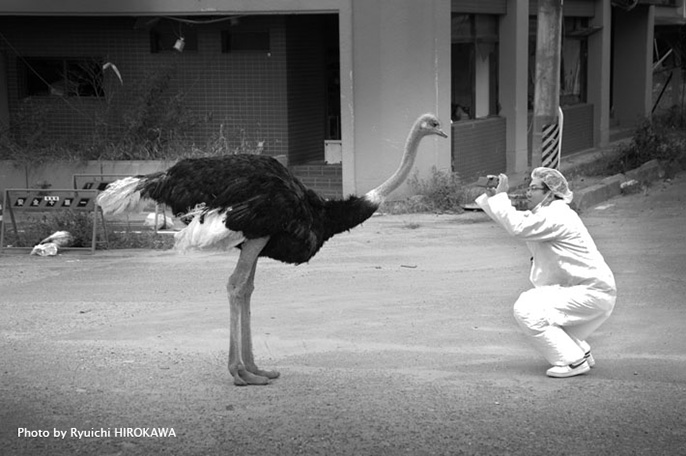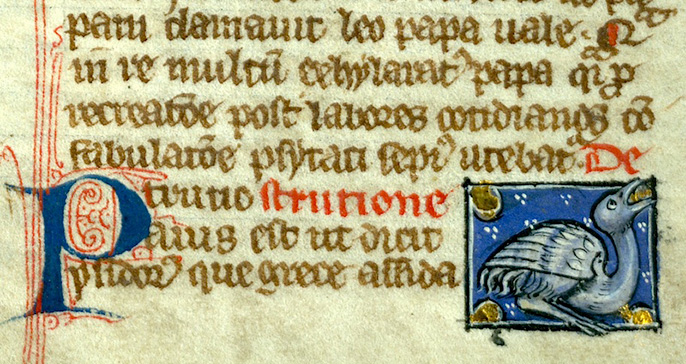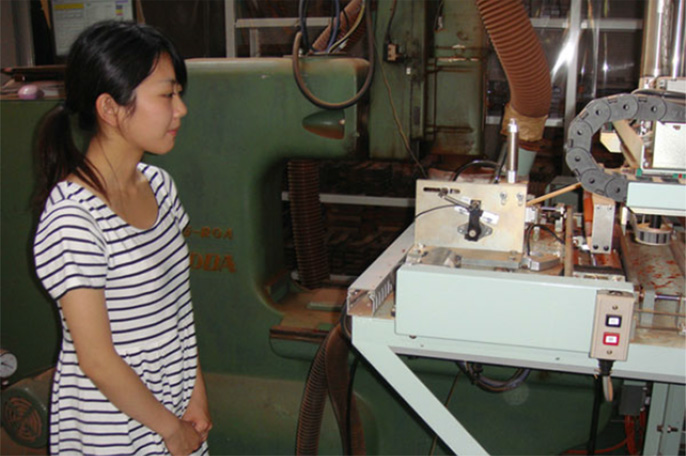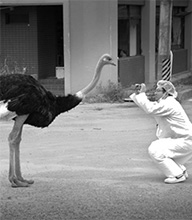Original Caption:
11?12???????????????????????????????????????????????????????????????????????????????????????????????????????????????????????????10??????????????????????20km?????????????????????????????????????????????????

Amid the fallout of Fukushima, ten ostriches heralded Japan's transformation into an authority on nuclear safety
IN the first year after the Great East Japan earthquake, tsunami and nuclear disaster of March 11, 2011, people venturing into the twenty-kilometer exclusion zone around the stricken power plant in Fukushima found only a few signs of life. “The reality is harsh,” reported photojournalist Ryuichi Hirokawa, visiting that October. “I did not see so much as a human shadow.” Instead he encountered something less human: a lone ostrich, “calmly strutting about.”
Ostriches were a common apparition of the radioactive zone, striding across blogs and newspapers, a mascot of the 3.11 disaster’s social media life that were seemingly more meme than flesh. But they were real. After the evacuation ten of the birds had escaped from Ostrich Paradise Strauss Land, a shabby tourist-trap farm just seven kilometers from the nuclear plant. They were raised there by a 73-year-old farmer, Toshiaki Tomizawa. He had sold leather belts and ostrich croquettes to visitors, fresh from the farm. Just one month before the earthquake he invited the presenter of a children’s TV program for a cooking lesson, preserving a snapshot of happier times. He explained to her how he opened the park with inspiration from the power plant itself, which had once chosen the ostrich as a mascot and had kept at least one animal at the reactor for photographs.
Abandoned, ten of Tomizawa’s ostriches slipped through a hole in the fence at Strauss Land and took to the silent open spaces of the exclusion zone. There they lived off the radioactive land, favoring rice fields and wide streets that granted them a commanding view over their environment. Unlike other animal survivors they never hid. As they were encountered and photographed, they began to constitute a post-apocalyptic genre all their own. In images the birds wander the space where apocalypse straddles the gothic and comic, a Fallout game designed by Chuck Jones.
Political scientist Richard J. Samuels identified the post-3.11 watchword of the nuclear utility company TEPCO, and many in the government, as s?tegai, meaning “unimaginable”: the combined catastrophe of a 9.0 earthquake and nearly fifty-foot tsunami was so extraordinary that no designer could have conceived of it before it happened, let alone built for it. The sheer bizarreness of the ostriches’ presence seemed to support this contention that 3.11 was a fault in reality, exceeding even the imagination. (English-language commentators preferred another imported bird, the black swan, as a metaphor.) Yet TEPCO’s critics combated the s?tegai defense year after year. In February 2016, three executives were finally indicted on charges of professional negligence, on grounds that they had ignored a 2009 internal report in which a fifty-foot tsunami was, in fact, imagined with some clarity. Throughout the long anti-nuclear campaign activists have reinterpreted the symbol of the ostrich, suggesting that TEPCO’s management were the ones with their heads in the sand.
Ostriches also appealed to the contingent of animal lovers who focused intensely on the abandoned pets and livestock of Fukushima Prefecture. Their hero, 56-year-old Naoto Matsumura, has remained in the zone for the last five years to care for a menagerie of animals, steadily accumulating cesium isotopes and media attention. The so-called St. Francis of Fukushima rescued two of the ostriches, constructing a tidy pen for them, and they became his most photographed wards. He even indulged an ostrichpunk fantasy: speaking to a Vice filmmaker in 2013, he mused, “You could probably ride these. With training, you could bridle them and ride them to town.”
Another seven escapees were rounded up by a squad from the Ministry of Agriculture in January 2012, aside from one elusive male who remained in the wild until that May. The squad approached the ostriches from behind and pulled black cloth sacks over their heads, upon which the birds—being birds—fell quiescent. The team transported them back to Strauss Land, where Tomizawa offered them to Tokyo University of Agriculture for study.
Scientists from the university, led by livestock researcher Hiroshi Ogawa, kept the five male and two female ostriches in their pens in the exclusion zone and visited weekly to bring them fresh, uncontaminated dog food and water. Thirty-four days into the experiment they euthanized one of the birds with an injection of anesthetic to the neck vein and measured the concentrations of radioactive cesium in its muscles and organs. (Cesium accumulates in muscles, unlike strontium, which lodges itself permanently in bones.) This was repeated regularly at intervals up to 405 days from capture. The last bird was killed on May 25, 2013. According to the published study, all were found to be in “relatively good health given the fact that they had been wandering outdoors for some time.”
The detox diet was never completely successful, however. Autopsies showed that radioactive cesium declined in the first 287 days after capture, but leveled off after that. Readings remained highest in the birds’ stomach and rectal contents. The scientists blamed this on the ostriches’ eating habits; it was “likely from consumption of soil or plants within or outside the enclosure, rather than the clean feed administered.”
Ostrich appetites are an ancient preoccupation in the history of science. “They have the marvelous property of being able to digest every substance without distinction,” wrote Pliny the Elder in his Natural History. Many an ancient scientist, and some as recently as the eighteenth century, coaxed ostriches into eating an assortment of scrap metal to record the (often disappointing) results. Classical and medieval sources in Europe, China and Arabia attested to the willingness of the birds to eat pieces of iron—even red-hot iron. In a ninth-century Arabic source, two scholars fed an ostrich burning embers, heated bits of metal, and then a pair of red-hot scissors, which finally pierced its neck and killed it.

Consumption of dangerous substances was once as iconic an ostrich legend as their supposed head-burying follies. It’s largely been forgotten, but not entirely. When TEPCO chose the bird as a mascot for its Fukushima plant, it was with the logic that ostriches, like nuclear reactors, produce a lot of energy from small and unusual inputs of fuel.
The scientists who studied the radioactive ostriches of Fukushima wanted to bring the animals back to conventional energy. However, there’s a larger context to their attempt. The ostrich study was published in 2015 in an English-language book produced by Tokyo Agricultural University, Agricultural and Forestry Reconstruction After the Great East Japan Earthquake: Tsunami, Radioactive, and Reputational Damages. The research recorded in the book was all part of the university’s East Japan Assistance Project, a hands-on effort to bring recovery to devastated local industries surrounding the small city of Soma. The experiments included spreading steel mill slag over tsunami-inundated rice fields to remove salt and lower acidity; plowing minerals called zeolites into radiation-affected fields that would stop plants from absorbing the cesium in the soil; turning over a permanently flooded village to clam cultivation; and planting grasses over open land to soak up isotopes. The first harvests of rice grown on slag-restored fields were branded as Soma Revival Rice and distributed to elementary and junior high school lunch rooms in the area.
Where the ostriches fit into all of this is not immediately obvious. Ostriches are not in themselves a significant commodity in Japan, although their feathers play a hidden role in the automotive industry, where since the 1980s the manpower-intensive job of “tacking off” vehicles before painting has been taken over by robots wielding giant ostrich-feather dusters. Furthermore, livestock weren’t on the list of things that needed remediating; within the exclusion zone most of them were culled by the Prefectural Government, and farmers who declined to participate in the cull were strictly forbidden from selling any of their products. The experiment didn’t look like a solution for reconstructing farming in the zone, any more than Matsumura’s fantasy of bridled ostriches was a solution for reconstructing transportation infrastructure.
I asked the lead author, Hiroshi Ogawa, about the reasons for the study. His answer was straightforward: the researchers aimed to demonstrate “the possibility of safe reuse of the domestic animal that was contaminated by radioactive materials.” In essence, the design of the experiment fit the ostriches into the larger project’s themes of reconstruction, recovery and remediation. Framed differently it could have been otherwise. If the scientists had brought fresh ostriches to Strauss Land, they might have learned something more relevant to re-establishing livestock in the contaminated zone—but their radiation levels would have risen with time, not followed the descending scale that runs through the entire book. Only the highly radioactive escaped ostriches would fit the refrain.
When the Ministry of Agriculture forbid the transfer of any animals or their products from the evacuation zone, Ogawa says, the ostriches’ owner decided to contribute to scientific research rather than simply kill them. Many other farmers made the same decision. Dozens of studies took Geiger counters to cattle, horses, chickens and pigs, as well as wild monkeys, sika deer, mice, spiders and insects. Yet most of these fit into one of two experimental designs. Animals from different locations (including other ostriches) were simply autopsied to measure the penetration of radiation; or clean animals were given contaminated feed.
The Strauss Land study was something else. Purifying those ostriches on this land was a scientific performance, asserting an uncompromising hope that Fukushima Prefecture and all of its life forms and livelihoods could be reconstructed. Beyond just trying to bring communities back to Fukushima Prefecture, the university’s overall project extended this place-attachment to the compounds of the soil itself, committing to a biopolitical control of chemical processes running through the environment. The authors maintained that farmers should remove nothing from the landscape but rather mix new substances into the soil while plowing the tsunami sludge back in, keeping everything in place. With proper care anything could be redeemed—soil, animals, rural lives. This is in contrast to the ongoing practice of removing radioactive topsoil, which the government has been sealing in millions of plastic bags and stacking into monumental black mounds around Fukushima Prefecture. The remove-and-seal approach imagines sweeping the landscape clean like the body of a new Nissan. Instead of removal, the university’s project proposes safety through careful regulation of processes at the boundary between land and organism—though this regulation is violated by the ostriches’ snaking necks and searching beaks.
Perhaps the most important point about the university’s book is that it was published in English, by the scientific publishing giant Springer (although the university earlier published individual results in its own bulletin). This widens the question of who the performance was for. When nations and businesses seek international help after a disaster—or to prepare for disasters to come—it’s the most hazardous of the developed countries that they look to first, on the theory that experience counts. Tragedy is reconstructed as lessons learned. The Netherlands is the leading brand in flood and storm surge protection; Australians advise on wildfire fighting; the best volcanologists can be found in Iceland or the US’s fiftieth state. Japan is the undisputed leader in managing seismic risks and, as of the last five years, nuclear risks.
Tokyo University of Agriculture’s book can be read as an advertisement for the internationally well-connected school as a potential partner in future projects and as an advertisement for Japan’s brand of refined technocracy in general. These disaster brands travel smoothly from humanitarian to diplomatic to commercial ends, whether offering expertise to seismically smart housing reconstruction in Nepal or the most advanced skyscrapers in shaky global capitals. As Japan builds a 250-mile chain of enormous seawalls to further armor its coast after 3.11, the Philippines is seeking its technical assistance to do the same along seventeen miles of shore around Typhoon Haiyan-struck Tacloban. Most such projects in poorer countries go under the banner of the Japan International Cooperation Agency (JICA), one of the world’s largest development organizations and, since 2008, a concessional lender to developing countries. JICA also has a long legacy in agricultural cooperation, often making use of student volunteers from Tokyo University of Agriculture and leveraging Japan’s reputation for the most advanced farming in the world. These activities are in highest demand where agriculture and disaster walk hand in hand—not least in African countries where ostriches roam.
Post-3.11, Japan is also taking its nuclear experience global. The country’s nuclear industry was already gearing up this “new growth strategy” before disaster struck, with countries like Jordan, Lithuania and Vietnam expressing interest in Japanese nuclear technology and the Japanese development assistance to procure it. The international orientation was greatly reinforced by the turmoil of domestic nuclear power after 3.11, with corporations needing to look elsewhere for projects.
The first successful bid ended up being in Turkey, one of the few countries that comes close to Japan in the occurrence of earthquakes. Despite its seismic risks the heavily energy-importing country is determined to get its second nuclear facility up and running quickly. It will be built in Sinop, ancient birthplace of Diogenes the Cynic, which sits on a small peninsula between the North Anatolian Fault and the Black Sea. The deal was signed in May 2013, the same month that the last of the radioactive ostriches at Strauss Land reached the end of its allotted lifespan. The $22 billion contract to build, own and operate the plant went to a consortium of Mitsubishi Heavy Industries—one of the companies that built the Fukushima reactor—with trading house Itochu and France’s Areva. For Mitsubishi it marks a first post-Fukushima win and a first venture into operating a nuclear plant.
The deal was momentous enough to be signed by Prime Ministers Shinzo Abe and Recep Tayyip Erdo?an in person. Far from skirting the shadow of 3.11, both leaders cited Japan’s experience as a factor in the agreement. Said Abe, “We believe Japan will transfer its experiences and the lessons it learned from serious accidents to nuclear studies and will contribute to ensuring nuclear safety at the top level.” Added Erdo?an, “What happened at Fukushima upset all of us. But these things can happen. Life goes on.” Construction is set to begin in 2017.
The Japanese builder-owner-operators do bring a lot of experience to Turkey. So does JICA, which implements much smaller-budget disaster education and seismic construction projects around the country. They also bring along particular logics of safety and control. Some logics promise to scrub away and seal up risk; others to retreat from it; and others to normalize it, posing that life in a contaminated zone might go on as usual, that ostriches, rice and people might return to the farm unscathed. This latter outlook visualizes safety as a shell around bodies and assets, armoring against environmental dangers that are impossible to eliminate (or sometimes even imagine). Soil additives can protect crops at the root tip; local people can keep themselves and their animals clean. But all bodies, not just ostriches, are voracious, and risks don’t stay on the outside.
Nevertheless, Tokyo University of Agriculture’s book of project reports is resolutely optimistic about mastering the dangers of Fukushima. Finishing on a particularly high note, it ends with three chapters of reflective essays from students and farmers who participated in the reconstruction experiments. “Studying Forest Radiation Contamination Changed My Outlook on Life,” promises one title. Bioscience student Chihiro Kinoshita delivers the book’s coda in a final essay, “Finding a Way to Live with Cesium.” A photo shows her standing before a laboratory measuring device, hands clasped, contemplative.

Finding a way to live with cesium, embracing a more radioactive world, is a curious ambition. Perhaps the ostriches of Fukushima were leading the way. Although they made a shambles of the science, while they strutted through the exclusion zone they did seem to live up to their legendary capacity to subsist on all materials hot and heavy. But the nuclear disaster was itself a consequence of an industry indulging strange appetites, an industry which not coincidentally treated the ostrich as a mascot. Five years on, its appetites have proven just as hard to restrain. It probes the ground, here and there, hungry. It only appears from a distance to be burying its head.
